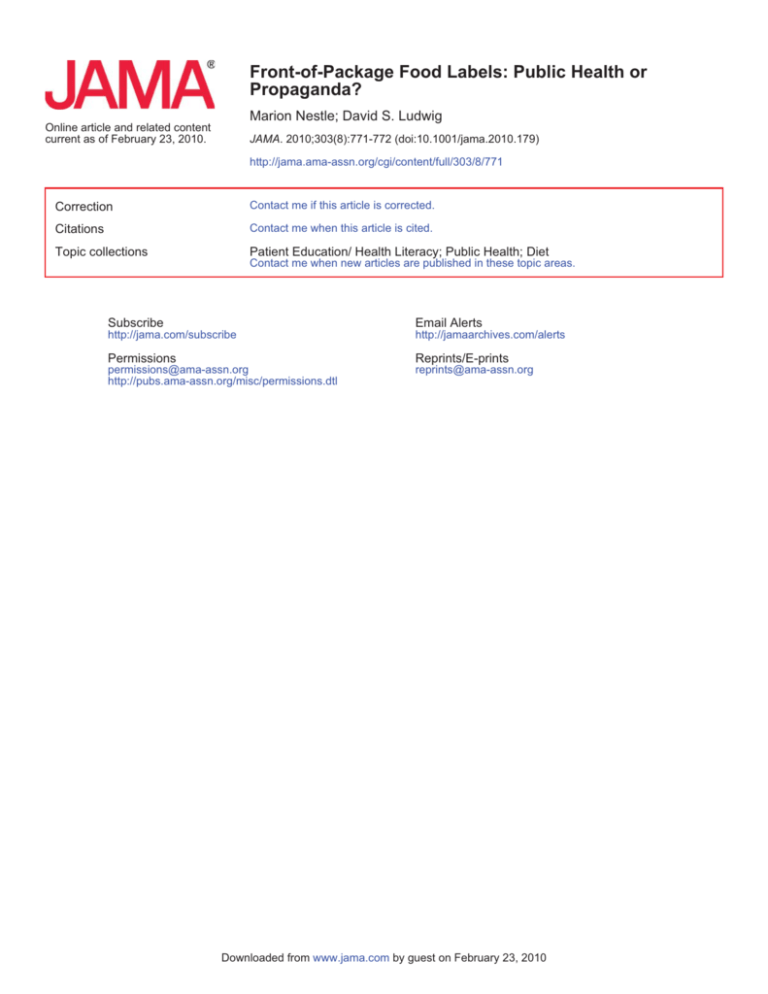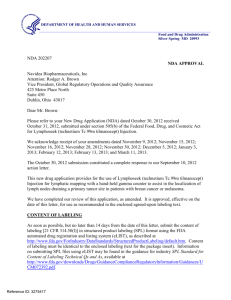
Front-of-Package Food Labels: Public Health or
Propaganda?
Marion Nestle; David S. Ludwig
Online article and related content
current as of February 23, 2010.
JAMA. 2010;303(8):771-772 (doi:10.1001/jama.2010.179)
http://jama.ama-assn.org/cgi/content/full/303/8/771
Correction
Contact me if this article is corrected.
Citations
Contact me when this article is cited.
Topic collections
Patient Education/ Health Literacy; Public Health; Diet
Contact me when new articles are published in these topic areas.
Subscribe
Email Alerts
http://jama.com/subscribe
http://jamaarchives.com/alerts
Permissions
Reprints/E-prints
permissions@ama-assn.org
http://pubs.ama-assn.org/misc/permissions.dtl
reprints@ama-assn.org
Downloaded from www.jama.com by guest on February 23, 2010
COMMENTARY
Front-of-Package Food Labels
Public Health or Propaganda?
Marion Nestle, PhD, MPH
David S. Ludwig, MD, PhD
A
T NO POINT IN US HISTORY HAVE FOOD PRODUCTS
displayed so many symbols and statements proclaiming nutrition and health benefits. Front-ofpackage claims, often used in violation of Food
and Drug Administration (FDA) labeling regulations, have
become ubiquitous in food marketing.1,2 Recently, the FDA
embarked on an initiative to review front-of-package labeling and asked the Institute of Medicine to consider eventual recommendation of a single, standardized guidance system. Front-of-package labels may so thoroughly mislead the
public that another option deserves consideration—
eliminate all nutrition and health claims from the front of
processed food packages while strengthening the Nutrition Facts Panel.
A Century of Regulatory Conflict
In 1906, the Pure Food and Drug Act prohibited food labels from bearing statements that were “false or misleading
in any particular,” a proscription interpreted to mean that
labels could not display health claims. Food manufacturers successfully challenged this interpretation in court. In
1912, Congress passed the Sherley Amendment authorizing actions against health claims that were false and fraudulent. For decades, the FDA interpreted any statement of health
benefit as meeting both criteria.
Companies could, however, list nutrient contents. Manufacturers understood the marketing potential of this exemption and began fortifying foods with vitamins almost as soon
as they were discovered. The FDA attempted to limit fortification to nutrients important for public health, but companies pressed for the right to use more.
In 1969, President Nixon convened the White House Conference on Food, Nutrition, and Health to explore ways to
end hunger and malnutrition. A food industry task force recommended nutrient fortification, not only of wheat, corn, and
rice, but also of snack foods and chocolate.3 To address public health goals, the FDA permitted food packages to indicate “contains 7 essential nutrients,” but continued to prohibit statements that food products could prevent, treat, or
mitigate disease. These, the agency insisted, constituted drug
claims requiring scientific substantiation.
©2010 American Medical Association. All rights reserved.
In 1984, Kellogg arranged with the National Cancer Institute to endorse a health claim for All-Bran cereal. Within 6
months, All-Bran’s market share increased by 47%, sending
an unmistakable message that health claims sell products.4
Subsequently, Kellogg filed a “citizens’ petition” with the FDA
arguing a legal basis for health claims.5 Congress incorporated the petition’s suggestions when it passed the Nutrition
Labeling and Education Act of 1990 instructing the FDA to
authorize scientifically substantiated health claims on foods.
In 1994, Congress passed the Dietary Supplement Health
and Education Act, which permitted supplement labels to
claim support for some structure or function of the body.
Food companies demanded similar claims. The FDA Modernization Act of 1997 and lawsuits during the Bush administration weakened the FDA’s power to stop them. Three
types of claims—nutrient-content, health, and structure/
function—proliferated on food products.2
Another type of food labeling, endorsements of nutritional quality, began to appear in 1995, with the American
Heart Association’s symbol indicating heart-healthy products low in total fat, saturated fat, sodium, and cholesterol.
More recently, PepsiCo, Kraft, and other companies developed self-endorsement labeling systems, and General Mills
introduced nutrition-at-a-glance symbols. Such symbols are
now so plentiful that Consumers Union sponsors a Web site
to track and evaluate them.6
Misleading Nature of Current Practices
The bewildering array of claims for increasingly remote health
benefits has recently elicited concern. The Smart Choices program, a voluntary initiative involving several food companies, was the focus of an exposé by the New York Times and
was threatened with legal action by the Connecticut attorney general.7 The program is now suspended. The San Francisco city attorney forced Kellogg to remove a claim that sweetened breakfast cereals “help support your child’s immunity.”
The FDA now intends to examine the entire issue of frontof-package labeling, insisting that the systems used “be nutritionally sound, well-designed to help consumers make inAuthor Affiliations: Department of Nutrition, Food Studies, and Public Health, New
York University, New York, New York (Dr Nestle); and Optimal Weight for Life
Program, Department of Medicine, Children’s Hospital, Boston, Massachusetts (Dr
Ludwig).
Corresponding Author: David S. Ludwig, MD, PhD, Division of Endocrinology, Children’s Hospital, 300 Longwood Ave, Boston, MA 02115 (david.ludwig@childrens
.harvard.edu).
(Reprinted) JAMA, February 24, 2010—Vol 303, No. 8
Downloaded from www.jama.com by guest on February 23, 2010
771
COMMENTARY
formed and healthy food choices, and not false or misleading.”
The FDA also argues that “point of purchase labeling, including front-of-package labeling or corresponding shelf labeling . . . can be an effective way of promoting informed food
choices and helping consumers construct healthier diets.”8
For a century, food manufacturers have lobbied for the
right to use health claims in marketing, justifying their demands on precisely these grounds. Health claims demonstrably promote sales. But do they promote health? Research suggests that consumers believe front-of-package
claims, perceive them to be government-endorsed, and use
them to ignore the Nutrition Facts Panel.9,10 Indeed, current practices may mislead the public in several ways:
(1) Few, if any, claims can be verified. To be marketed, drugs
must be proved safe and effective through randomized controlled trials. Although specific dietary components may be
linked to improved health outcomes, food products containing that dietary component might not have the same effect.
A diet of whole and minimally processed foods provides more
than 40 essential nutrients and countless phytochemicals that
interact in complex ways to promote health. The claim, for
example, that a refined breakfast cereal could boost a child’s
immune system due to the presence of few antioxidants is
tenuous at best. No independent agency would likely invest
funds in high-quality clinical trials to test such possibilities.
(2) Claims based on individual nutritional factors are misleading. Whereas drug adverse effects must be disclosed in
advertisements, front-of-package health claims have a selective focus, ignoring the presence of potentially unhealthful aspects (eg, the sugar or salt content in a prepared breakfast cereal).
(3) Even front-of-package labels restricted to nutrient content can be deceptive by presenting information out of context. Although an 8-oz serving of a sugared beverage has fewer
calories than a 1-oz serving of nuts, a dietary choice based
on this difference would be misguided.
(4) “Healthier” processed foods are not necessarily healthy.
Manufacturers can manipulate snack food ingredients by replacing fat or sugar with refined starch, yielding a higher
rating score with little meaningful improvement in nutritional quality. Moreover, health claims confer an aura of
healthfulness that might encourage consumption of products of poor nutritional quality.
(5) Front-of-package claims produce conflicts of interest. Unless the FDA specifically dictates allowable claims for
each food product (a logistically unfeasible approach), food
companies’ interest in selling more products will undermine the educational purpose of labeling.
Recommendations
If health claims are allowed on food packages, they should
be regulated more strictly according to rigorous, evidencebased national standards. Because such standards are in-
772 JAMA, February 24, 2010—Vol 303, No. 8 (Reprinted)
evitably arbitrary and subject to manipulation, consideration should be given to an outright ban on all front-ofpackage claims. Doing so would aid educational efforts to
encourage the public to eat whole or minimally processed
foods and to read the ingredient lists on processed foods.
In addition, the Nutritional Facts Panel should be revised
and updated to facilitate informed dietary choice and minimize the possibility of marketing manipulation. Presently,
consumers may greatly underestimate the calories in a 20-oz
bottle of sugared beverage, for example, because the Nutrition Facts pertain to a serving size of 8 oz.
One remaining issue is the First Amendment. In its 1985
petition, Kellogg argued that First Amendment guarantees
of commercial free speech establish companies’ rights to make
health claims.5 Although the courts seem to have interpreted the Amendment in this manner, the issue warrants
reconsideration in light of current marketing practices.
Claims that sugar-sweetened products make children smarter
or boost their immunity are reason enough for the FDA to
take this issue back to court and for Congress to consider
legislative remedies.
Financial Disclosures: Dr Nestle reported receiving royalties from books about food
politics. Dr Ludwig reported receiving royalties from a book about childhood obesity and grants from foundations and the National Institutes of Health for obesityrelated research, mentoring, and patient care.
Funding/Support: Dr Ludwig is supported in part by career award K24DK082730
from the National Institute of Diabetes and Digestive and Kidney Diseases.
Role of Sponsors: The National Institute of Diabetes and Digestive and Kidney
Diseases had no role in the preparation, review, or approval of the manuscript.
Disclaimer: The content of this Commentary is solely the responsibility of the authors and does not necessarily represent the official views of the National Institute
of Diabetes and Digestive and Kidney Diseases or the National Institutes of Health.
Additional Contributions: We thank Kelly Brownell, PhD, director, Rudd Center
for Food Policy and Obesity, Yale University, New Haven, Connecticut, and Ronald Krauss, MD, director of Atherosclerosis Research, Children’s Hospital Oakland
Research Institute, Oakland, California, for their critical reading of the manuscript. Neither received compensation for their contributions.
REFERENCES
1. Silverglade B, Heller IR; Center for Science in the Public Interest. Food labeling
chaos: the case for reform, December 2009. http://cspinet.org/new/pdf
/food_labeling_chaos_report.pdf. Accessed January 24, 2010.
2. Brandt MB, Moss J, Ellwood K, et al. Tracking label claims. Food Technol. 2010;
64(1):34-40.
3. 1969 Conference on Food, Nutrition, and Health: full report. http://www.nns
.nih.gov/1969/full_report/PDFcontents.htm#top. Accessed January 24, 2010.
4. Levy AS, Stokes RC. Effects of a health promotion advertising campaign on sales
of ready-to-eat cereals. Public Health Rep. 1987;102(4):398-403.
5. A citizen’s petition: the relationship between diet and health. Battle Creek, MI:
Kellogg Co; May 22, 1985.
6. Consumer Reports. Greener choices: products for a better planet. http://www
.greenerchoices.org/eco-labels/productArea.cfm?ProductCategoryID=174. Accessed January 24, 2010.
7. Neuman W. Food label program to suspend operations. New York Times. October 24, 2009:B1.
8. Hamburg MA. FDA response to Representative DeLauro, October 19, 2009.
http://www.fda.gov/food/labelingnutrition/labelclaims/ucm187369.htm. Accessed January 24, 2010.
9. Wansink B. How do front and back package labels influence beliefs about health
claims? J Consum Aff. 2003;37(2):305-316.
10. FDA. Consumer research on food labels. http://www.fda.gov/Food
/ScienceResearch/ResearchAreas/ConsumerResearch/ucm080407.htm. Accessed January 24, 2010.
©2010 American Medical Association. All rights reserved.
Downloaded from www.jama.com by guest on February 23, 2010








